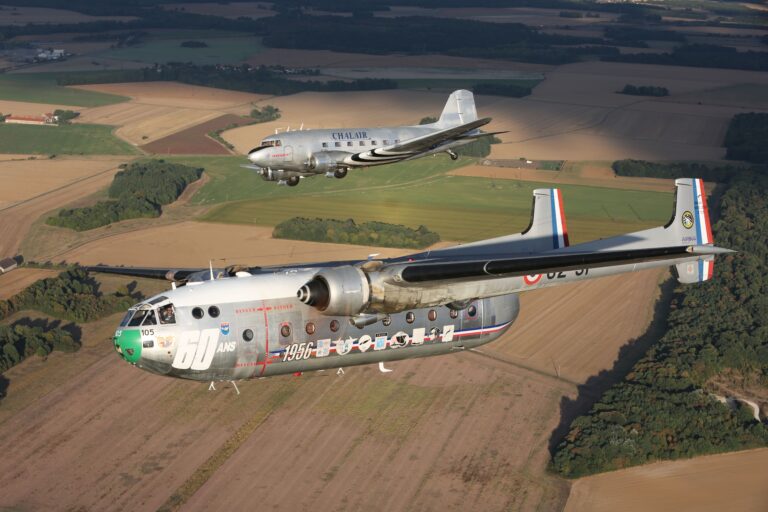Nord 2501 “Noratlas”, F-AZVM
At the end of the Second World War, the French Air Force needed a structured and reliable air transport.
Equipped with a variety of aircraft (Douglas C-47 “Dakota”, Junker 52 “Toucan”…), it needed an aircraft with the capacity to carry and parachute personnel and heavy equipment to carry out the specific missions it was required to carry out. To meet this demand, the Société Nationale de Constructions Aéronautiques du Nord (S.N.C.A.N.) designed in July 1948 a single-fuselage, double-girder prototype in the shape of a streamlined wagon, equipped with two removable side doors, which offered the possibility of horizontal loading of its hold thanks to its tricycle landing gear and the “petal” opening of its rear section.
The Nord 2500 n° 01, equipped with two Gnome and Rhône 14R engines of 1625CV took off for the first time on September 10, 1949 from Melun-Villaroche, piloted by Claude Chautemps and Georges Détré.
Very quickly, the tests showed the qualities of this aircraft and it was put on the assembly line at Bourges under the name Nord 2501 NORATLAS, receiving its definitive engine, the Bristol Hercules 759, built under licence by SNECMA. Its 1615 hp Hercules XVI version equipped the famous RAF bombers, the Handley Page Halifax, the AVRO Lancaster and the Bristol Beaufighter to name but a few. Rustic, solid and autonomous, it is powered by a fuel injection carburettor, a technical marvel designed by a woman, Miss Hobson.
Production in France and Germany reached 426 units (240 assembled in Bourges by Nord Aviation, and 186 in Hamburg-Finkenwerder by Flugzeubau Nord Gmbh (Norflug).
In addition to the French and German air forces, it equipped the Greek, Israeli and Portuguese armies. There were versions equipped with Turboméca Marboré II engines in wingtips and fuelled by petrol for the French Navy and some civilian versions operated by UAT, the forerunner of UTA, which later became part of Air France.
With a maximum take-off weight of 21.7 tonnes (useful load of 5 tonnes), it cruises at 320 km/h. Unpressurised but effectively defended against icing, its flight autonomy of almost 10 hours in limit conditions allowed it to fly 2500 km in complete safety.
On 29 May 1954, 22 days after the fall of Dien Bien Phu, the ANJOU group then stationed in Indochina was equipped with its first Noratlas.
Later, in France and Algeria, it would equip all the operational units grouped within the GMMTA (Groupement des Moyens Militaires de Transport Aérien) which would become COTAM (Commandement du Transport Aérien Militaire), then FAP (Force Aérienne de Projection).
The Noratlas, affectionately known as the “Grise”, spearhead of the Air Force’s air transport, will criss-cross the world and parachute in all latitudes.
They took off from the biggest airfields and landed on tiny runways covered with stones and sand, refueled for a humanitarian mission after a war mission, transported, transported, transported again until 1986, the year of their definitive retirement from the air force, that is to say after 32 years of good and loyal service with great and small stories, joys, sorrows and dramas sometimes endured.
Nowadays, only one of these aircraft remains in the world in flying condition,
No. 105, which you will see at the AIR LEGEND air show.
Operator: Noratlas de Provence Manufacturing date: 1956 Serial number: n° 105 Livery: Armée de l'Air











